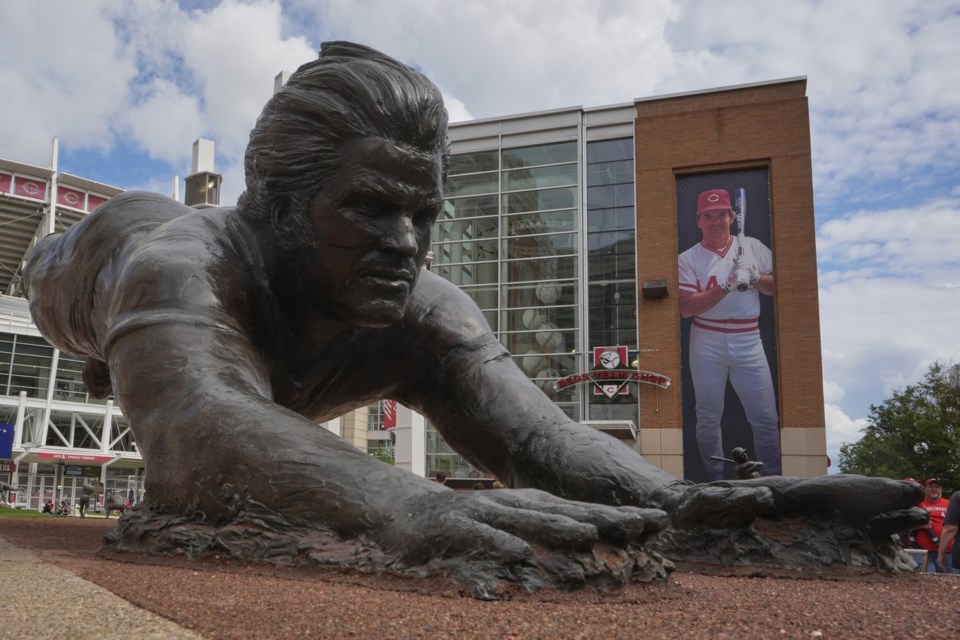CINCINNATI (AP) ŌĆö The Cincinnati Reds are paying tribute to Pete Rose on Wednesday night, a day after baseballŌĆÖs career hits leader was
The Reds are handing out a replica No. 14 Rose jersey to fans in attendance for their game against the Chicago White Sox. They are holding a pregame panel with former Rose teammates George Foster and Ken Griffey Sr., along with Barry Larkin and Eric Davis ŌĆö who played for Rose when he managed the Reds.
Members of Rose's family are slated to deliver the game ball and serve as honorary captains.
ŌĆ£He played baseball with as much passion and competitive enjoyment as you ever could,ŌĆØ said Reds manager Terry Francona, who played with Rose with Montreal and played for him with Cincinnati. ŌĆ£You wanted to be on his team.ŌĆØ
Rose, who died in September at age 83, played for the Reds in 19 of his 24 seasons, winning two of his three World Series championships with his hometown team. His career was tarnished by a gambling scandal that led to a permanent ban on Aug. 23, 1989.
An investigation commissioned by Major League Baseball concluded Rose ŌĆö a 17-time All-Star who finished with 4,256 hits ŌĆö repeatedly bet on the Reds as a player and manager of the team from 1985-87, a violation of a long-standing MLB rule.
Commissioner Rob Manfred announced Tuesday he was changing the leagueŌĆÖs policy on permanent ineligibility, saying bans would expire at death.
While Rose's gambling ban made him a baseball pariah, that was never the case in a city that proudly embraces its status as the home of the oldest major league team. He was almost uniformly beloved in his hometown for his all-out playing style and his connection to the Big Red Machine ŌĆö the dominant Reds teams in the mid-1970s.
ŌĆ£My dad used to tell me all the stories of how hard he played every time,ŌĆØ said Reds reliever Brent Suter, a Cincinnati native. ŌĆ£You know, never took a play off, always was running hard 90 (feet), sliding headfirst, you know, getting dirty every game. ... This was a guy who just embodied toughness, grit.ŌĆØ
There were long lines at several gates as the crowd filed into Great American Ball Park ahead of the pregame ceremony. A steady stream of fans stopped in front of Rose's statue for pictures before going inside the stadium.
There was a black tarp with the No. 14 over the pitcher's mound as the players took batting practice.
ŌĆ£I remember his hustle. The headfirst slides. He was a person with not a lot of talent, but he worked so hard,ŌĆØ said Bob Wunder, 65, of Dayton.
Wunder expressed his frustration with the timing of Manfred's decision.
ŌĆ£ItŌĆÖs awful. They should have done it when he was alive," he said. "If I was the (Rose) family, I would say ŌĆśThanks, but no thanks.ŌĆÖ IŌĆÖm upset that it had to wait until he passed away.ŌĆØ
The change in Rose's status makes him eligible for the Baseball Hall of Fame ŌĆö long a sore spot for Rose's most ardent supporters ŌĆö but his Cooperstown induction is far from a given.
Rose's case would be considered by the HallŌĆÖs Classic Baseball Era committee, which next meets to consider players in December 2027. A 10-person panel selects eight ballot candidates with the approval of the HallŌĆÖs board, and the group is considered by 16 members at the winter meetings, with a 75% or higher vote needed.
ŌĆ£I know I oversimplify things. But what Pete did as a player, if he's not in, there is no Hall of Fame,ŌĆØ Francona said. ŌĆ£But I get it. There are some things that ... I'm glad I don't have to make (those) decisions.ŌĆØ
Jerry Casebolt, 80, of Florence, Kentucky, stopped to get his photo taken in front of the Rose statue before the game. He said he was at the 1970 All-Star Game when Rose bowled over Ray Fosse in a memorable play at the plate, and he also attended the game when Rose broke Ty Cobb's hits record.
Casebolt embraced Manfred's decision to remove Rose from the ineligible list.
ŌĆ£It was great to hear the news," he said. "Just opening up the gates (to the Hall of Fame), but itŌĆÖs still questionable. Hope he gets in. Shame he didnŌĆÖt get to see it.ŌĆØ
___
AP MLB:
Jay Cohen, The Associated Press



